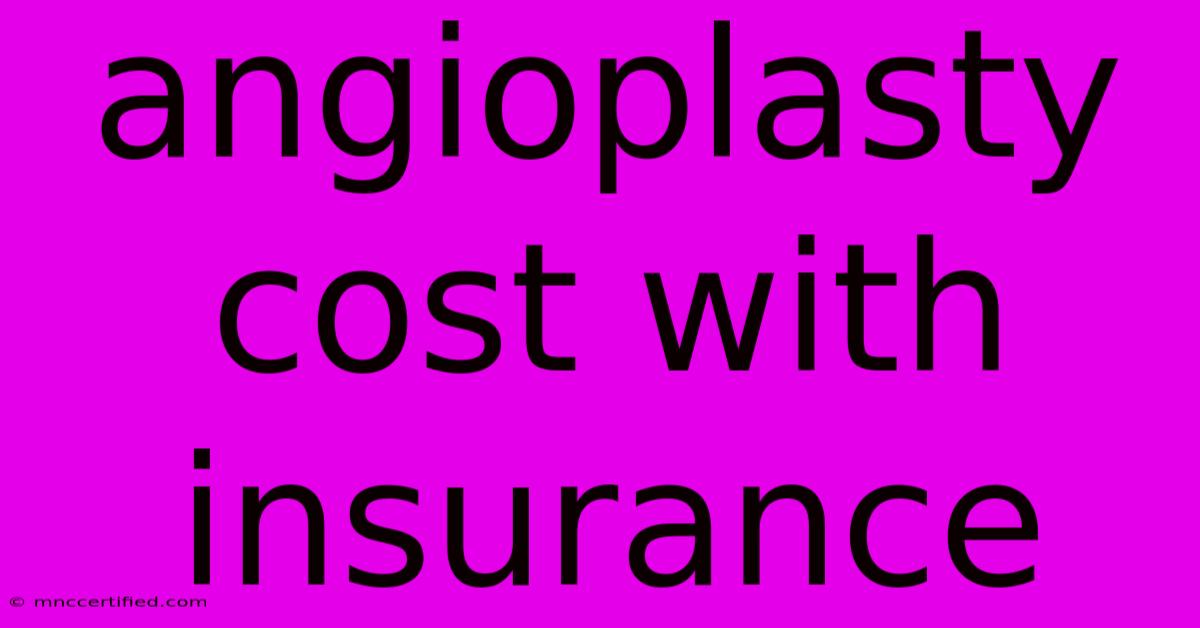Angioplasty Cost With Insurance

Table of Contents
Angioplasty Cost with Insurance: A Comprehensive Guide
Understanding the cost of angioplasty, especially with insurance coverage, can be daunting. This comprehensive guide breaks down the factors influencing the price, what your insurance likely covers, and how to navigate the financial aspects of this crucial procedure. We'll explore common questions and provide actionable steps to prepare for the financial implications of angioplasty.
What is Angioplasty?
Angioplasty, also known as percutaneous transluminal coronary angioplasty (PTCA), is a minimally invasive procedure used to open blocked or narrowed arteries, primarily in the heart. A small catheter with a balloon at the tip is inserted into a blocked artery, the balloon is inflated to widen the artery, and a stent (a tiny mesh tube) is often placed to keep the artery open. This improves blood flow and reduces symptoms of coronary artery disease (CAD), such as chest pain (angina).
Factors Affecting Angioplasty Cost
The cost of angioplasty varies significantly based on several factors:
- Location: Costs differ dramatically between geographical areas, with metropolitan areas generally charging more than rural locations.
- Hospital vs. Outpatient Center: Hospital procedures usually cost more due to higher overhead.
- Physician Fees: Cardiologist fees contribute significantly to the overall cost and can vary based on experience and location.
- Anesthesia Fees: The cost of anesthesia, whether local or general, adds to the total expense.
- Stent Type: The type of stent used (drug-eluting or bare-metal) impacts the cost. Drug-eluting stents are generally more expensive but can reduce the risk of restenosis (re-narrowing of the artery).
- Complications: Unexpected complications during or after the procedure will increase the overall cost.
- Length of Hospital Stay: If an overnight stay is required, the cost will be higher.
Angioplasty Cost with Insurance: What to Expect
Your out-of-pocket expenses depend heavily on your specific insurance plan. Here's what you should know:
- Insurance Coverage: Most health insurance plans, including Medicare and Medicaid, cover angioplasty, but the extent of coverage varies. Your plan's deductible, copay, and coinsurance will determine your personal cost.
- Premium: Your monthly insurance premium contributes to the overall cost of your healthcare, indirectly influencing your ability to afford angioplasty.
- Deductible: You'll need to meet your annual deductible before your insurance begins covering most expenses.
- Copay: You'll likely have a copay for the procedure itself and any associated visits.
- Coinsurance: This is your share of the cost after you've met your deductible.
- Out-of-Network Costs: If you receive care from an out-of-network provider, your out-of-pocket expenses will be significantly higher.
Understanding Your Explanation of Benefits (EOB)
After your procedure, your insurance company will send you an Explanation of Benefits (EOB). This document details the charges, payments made by your insurance, and your remaining responsibility. Carefully review this document to understand the billing process and identify any discrepancies.
Minimizing Angioplasty Costs
Here are some tips to help manage the costs:
- Negotiate Costs: In some cases, you may be able to negotiate the price of the procedure with the hospital or physician's office, especially if you're paying out-of-pocket.
- In-Network Providers: Choosing in-network providers ensures lower out-of-pocket costs.
- Financial Assistance Programs: Hospitals and healthcare providers often offer financial assistance programs to patients who can't afford treatment. Inquire about these options.
- Payment Plans: Explore payment plans offered by the hospital or physician's office.
Questions to Ask Your Doctor and Insurance Provider
Before your procedure, ask your doctor and insurance provider the following:
- What is the estimated cost of the angioplasty?
- What portion of the cost will my insurance cover?
- What are my out-of-pocket expenses likely to be?
- What payment options are available?
- What happens if I have unexpected complications?
Conclusion
The cost of angioplasty can be substantial, but insurance coverage significantly reduces the financial burden for many. Understanding your insurance plan, negotiating costs, and exploring financial assistance programs are crucial steps in navigating the financial complexities of this life-saving procedure. Remember to always communicate openly with your doctor and insurance provider to ensure a smooth and financially manageable process.
Keywords: angioplasty cost, angioplasty cost with insurance, cost of angioplasty, angioplasty insurance coverage, heart angioplasty cost, percutaneous transluminal coronary angioplasty cost, PTCA cost, angioplasty price, minimizing angioplasty costs, angioplasty financial assistance, angioplasty payment plans, explanation of benefits, EOB angioplasty, Medicare angioplasty coverage, Medicaid angioplasty coverage.

Thank you for visiting our website wich cover about Angioplasty Cost With Insurance. We hope the information provided has been useful to you. Feel free to contact us if you have any questions or need further assistance. See you next time and dont miss to bookmark.
Featured Posts
-
What Is Cyd In Health Insurance
Nov 25, 2024
-
Yield Protection Crop Insurance
Nov 25, 2024
-
Aparcamiento Insur Buenos Aires
Nov 25, 2024
-
American Eagle Insurance Agency
Nov 25, 2024
-
Amba Insurance Customer Service
Nov 25, 2024